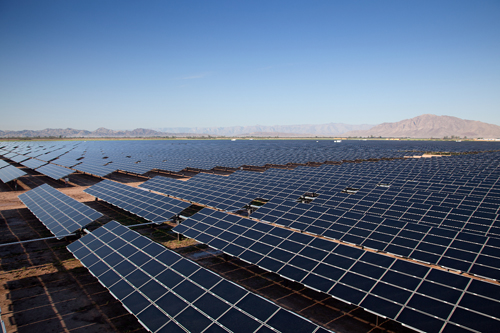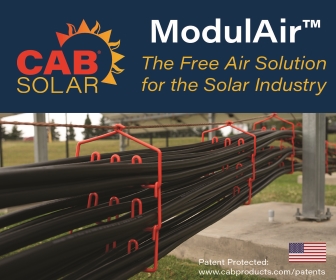Solar Tracking & Thin-film Technology: Technical considerations for a winning combination
 Mounting thin-film solar panels is a growing trend in the solar industry. Although these panels are typically installed on fixed-tilt racks, they’re also becoming increasingly popular in utility-scale solar tracking sites. This is especially true in the Southwest United States, since thin-film modules have a higher temperature coefficient, which gives them an energy-yield advantage in warmer climates. Solar tracking technology also has a proven track record of superior performance and higher energy gains in the southern states, leading to competitive levelized cost of energy (LCOE) rates that are too good to pass up.
Mounting thin-film solar panels is a growing trend in the solar industry. Although these panels are typically installed on fixed-tilt racks, they’re also becoming increasingly popular in utility-scale solar tracking sites. This is especially true in the Southwest United States, since thin-film modules have a higher temperature coefficient, which gives them an energy-yield advantage in warmer climates. Solar tracking technology also has a proven track record of superior performance and higher energy gains in the southern states, leading to competitive levelized cost of energy (LCOE) rates that are too good to pass up.
In addition to this trend, the recent announcement of US-imposed tariffs on Chinese module manufacturers will lead investors and project developers to look for alternative sourcing solutions to meet project deadlines and move pipelines forward. One potential option is the application of frameless thin-film modules that are manufactured in the United States.
This trend began last year, with the shipment and successful installation of thin-film modules for the 265-megawatt (MW) Mount Signal Solar, in Imperial County, California. The largest thin-film solar tracking facility in North America, Mt Signal Solar boasts more than three million thin-film modules on single-axis solar trackers.
Frameless racking challenges
The term “frameless” is somewhat of a misnomer. Although the modules arrive onsite with no frame, a custom structure must be designed and built to support them, according to manufacturer requirements. This approach can result in an extremely competitive fielded cost, but it also requires a great deal of forethought and custom engineering to bring prices to the lowest levels possible.
Frameless modules are almost twice as heavy per square foot, due to their glass-on-glass design that’s employed to help prevent breakage. They also have stringent support requirements, including specialty clips, rails with spacing, as well as structural requirements. Components must be tested and approved by the manufacturer, adding time and cost to the design and development process.
Proper, rapid installation is also a key requirement. Racks must be designed with innovative assembly techniques that allow field workers to quickly and safely install the modules, using proper clip attachment spacing and pressures. Breakage is a major issue with any type of glass installation, so protecting the thin-film modules during construction and over the life of the project is essential.
No substitute for experience
Crystalline modules have been designed to be universally compatible with many racking and tracking systems. Simple struts can be attached to almost any structure imaginable and, so long as the structure is robust enough, there will be few issues. This standardization is the result of many years of development, and most modules are basically interchangeable.
In comparison, however, frameless thin-film modules are still relatively young. Virtually all thin-film manufacturer modules are different in size, mounting requirements, cell design, or have other idiosyncrasies that distinguish them from their competition.
Due to the differences and nature of these modules, experience racking thin-film on solar trackers is a must-have quality. As the industry rapidly changes, tracking companies with a high level of experience and expertise will be a safe haven for installers and project owners.
When working with these unique designs, it’s common to encounter unforeseen problems because of their novelty and fragile nature. They’ve really only been on the market for a short amount of time. When designing the racking, small flaws in components could add up to massive costs for owners. For example, on the Mt Signal project, each set of four modules has 10 attachment clamps. Making a mistake that would require replacement of the clamps on this site would require servicing over seven million parts!
Therefore, it’s crucial to gain experience with small pilot projects first to find out what unanticipated problems might arise. In addition, there’s currently a profound lack of standardization in the approaches various tracking companies take when designing sites, and there are currently no official guidelines or codes for ground-mounted structures.
New companies must start from scratch, paying for wind tunnel testing on scale models to determine the design requirements for their site. Nevertheless, these types of tests don’t tell the whole story. There’s simply no substitute for years of practice with the hundreds of sites in the myriad of environments that exist. Experienced tracker companies will make special design considerations for wind, rain, snow, earthquakes, lightning, corrosion, and flooding—just to name some typical site problems over a 25-year life.
Safeguarding designs
A racking system created specifically for frameless thin-film modules that are mounted on solar trackers must be custom developed for each project. The system must be extremely rigid to prevent module damage, while including a well thought-out assembly that allows for rapid deployment onsite. Moreover, a minimization of materials is required to keep costs down, along with assembly tools to reduce install time in the field.
With frameless, glass-on-glass thin-film modules, it’s important to note certain considerations. For instance, although the tracking mechanism itself remains identical, less square footage can be tracked by one motor due to the heavy glass design. This must be accounted for during site layouts. Also, frameless thin-film modules require support at specific locations for attachment. To install these at the lowest possible price and support them properly, custom racks must be specifically engineered to match each module make and model.
Rapid installation times are just as important, particularly at a utility-scale site with over three million thin-film modules. Fortunately, workers can be trained in less than one day on how to properly install frameless modules on a well thought-out racking system. But, since the instructions and tools needed differ from traditional module installations, full documentation and a dedicated project management team for assistance in the field are a must. Training customers on best practices and installation techniques once a project has officially commenced is fundamental.
In the end, installation times at Mt Signal Solar were faster than expected, allowing for accelerated solar tracker shipments to the site, which were finalized seven weeks prior to the original schedule.
John Williamson is the lead engineer for Array Technologies, Inc.
Array Technologies, Inc.
http://arraytechinc.com
Author: John Williamson
Volume: September/October 2014










.png?r=9981)

